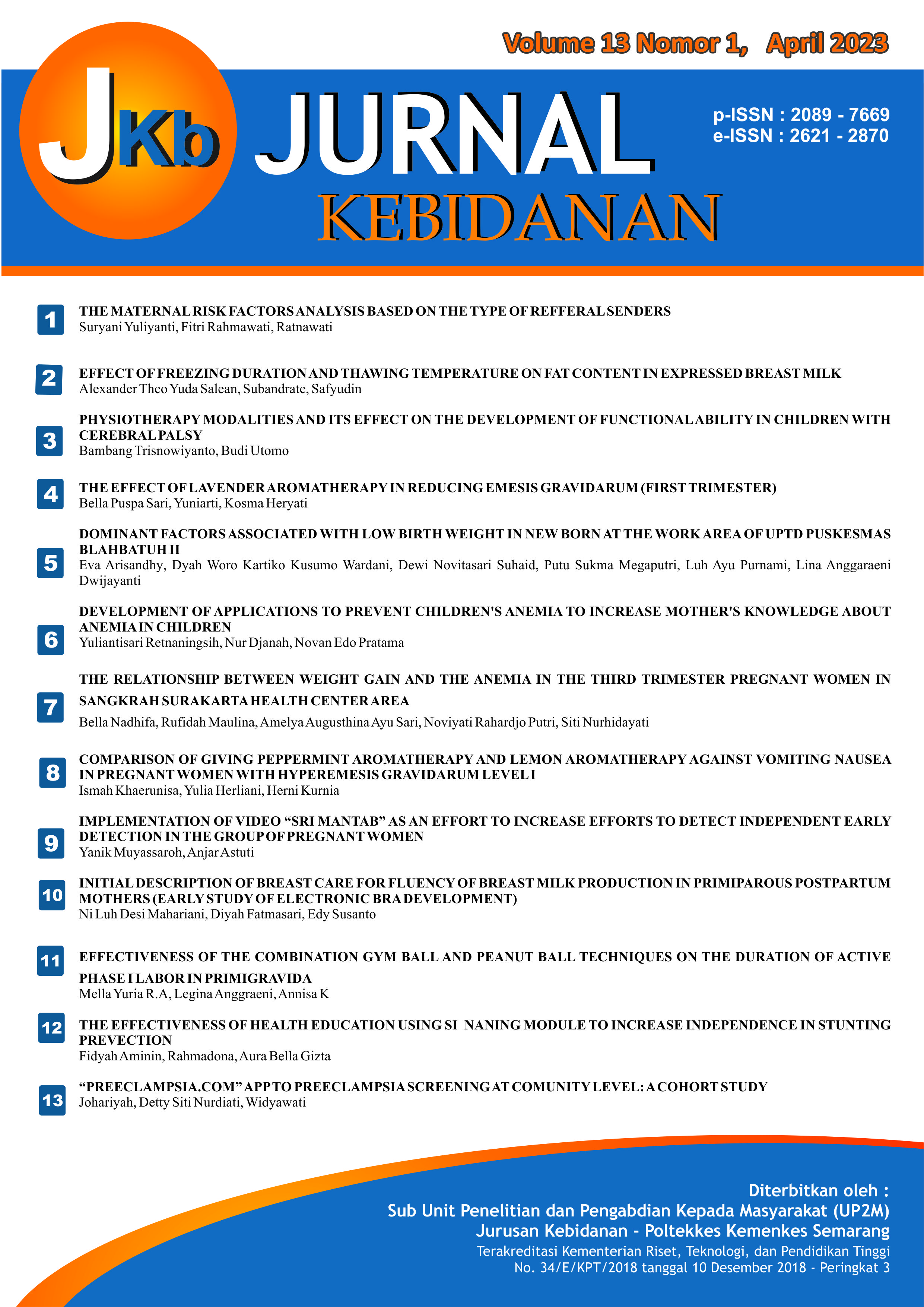The Effect of Lavender Aromatherapy in Reducing Emesis Gravidarum (First Trimester)
DOI:
https://doi.org/10.31983/jkb.v13i1.7551Keywords:
pregnancy, emesis gravidarum, lavender aromatherapyAbstract
Pregnancy is an event that occurs in a woman. Some uncomfortable things will come along with the physiological changes during pregnancy such as nausea, vomiting, and frequent urination. The most uncomfortable is nausea and vomiting (emesis gravidarum). Nausea and vomiting (emesis gravidarum) during pregnancy are common symptoms and often occur in the first trimester of pregnancy. One treatment to reduce non-pharmacological therapy is giving lavender aromatherapy. The purpose of this study was to determine the effect of lavender aromatherapy in reducing emesis gravidarum in the Telaga Dewa Public Health Center, Bengkulu City in 2021. The type of research used in this research is pre-experiment with One Group Pre-Test Post-Test design. The sampling technique in this study was using purposive sampling technique with a total sample size of 38 respondents and data collection using the PUQE-24 checklist sheet. The analysis method uses the Wilcoxon and Chi-Square test. The results of the Wilxocon test showed that there was an effect of giving lavender aromatherapy in reducing emesis gravidarum (p-value = 0.000). The results of the Chi-Square test showed that only one external variable had a relationship with the incidence of emesis gravidarum in first trimester pregnant women, namely parity obtained (p-value = 0.010). It is expected that pregnant women in the first trimester can apply lavender aromatherapy as an alternative to non-pharmacological therapy to overcome emesis gravidarum in first trimester pregnant women.
References
Sarwinanti and N. A. Istiqomah, “Perbedaan aromatherapi lavender dan lemon untuk menurunkan mual muntah ibu hamil,†J. Kebidanan dan Keperawatan ’Aisyiyah, vol. 15, no. 2, pp. 185–195, 2019.
W. W. Tanjung, Y. ; Wari, and A. Antoni, “Pengaruh Akupresur pada Titik Perikardium 6 terhadap Intensitas Mual Muntah pada Ibu Hamil Trimester I,†J. Educ. Dev., vol. 8, no. 4, pp. 265–270, 2020.
K. Paskana and V. Gusnidarsih, “Hubungan Paritas Dengan Kejadian Hiperemesis Gravidarum Pada Ibu Hamil,†J. Asuhan Ibu dan Anak, vol. 5, no. 2, pp. 25–29, 2020, doi: 10.33867/jaia.v5i2.187.
S. Rofi’ah, S. Widatiningsih, and A. Arfiana, “Studi Fenomenologi Kejadian Hiperemesis Gravidarum Pada Ibu Hamil Trimester I,†J. Ris. Kesehat., vol. 8, no. 1, p. 41, 2019, doi: 10.31983/jrk.v8i1.3844.
S. N. Abidah and Y. Anggasari, “Analisis Faktor-Faktor Yang Berhubungan Dengan Kejadian Anemia Pada Ibu Hamil Tm Iii Di Bpm Kusmawati Surabaya,†J. Heal. Sci., vol. 12, no. 02, pp. 99–108, 2019, doi: 10.33086/jhs.v12i02.812.
Yuliana, “Pengaruh Essensial Lemon Terhadap Emesis Gravidarum pada pada Ibu Trimester I di Kecamatan Natar Kabupaten Lampung Selatan,†Wellness Heal. Mag., vol. 2, no. February, pp. 187–192, 2019.
I. Andreyanto, I. T. Utami, and N. L. Fitri, “Penerapan Aromaterapi Lavender Dan Relaksasi Napas Dalam Untuk Menurunkan Intensiatas Nyeri Kepala Pada Pasien Chepalgia Di Kota Metro,†J. Cendikia Muda, vol. 3, no. 1, pp. 131–137, 2023.
Rosalinna, “Aromaterapi Lavender Terhadap Pengurangan Mual Muntah Pada Ibu Hamil,†Jambura Heal. Sport J., vol. 1, no. 2, pp. 48–55, 2019, doi: 10.37311/jhsj.v1i2.2489.
I. P. Ani and Machfudloh, “Bhamada Mual Muntah Treatment for Pregnant Mothers To Relieve Nausea ,†J. Ilmu dan Teknol. Kesehat., vol. 12, no. 2, pp. 20–26, 2021.
N. Mujayati, N. W. Ariyani, N. W. Ariyani, J. Mauliku, and J. Mauliku, “Efektivitas Aromaterapi Lemon Pada Penurunan Derajat Emesis Gravidarum Di Praktek Mandiri Bidan,†J. Ilm. Kebidanan (The J. Midwifery), vol. 10, no. 1, pp. 73–79, 2022, doi: 10.33992/jik.v10i1.1635.
D. N. O. Katil and M. W. Aisya, “Aplikasi Peran Variasi Aromaterapi Dalam Penurunan Nyeri dan Tingkat Kecemasan Pada Ibu Bersalin,†J. Ilm. Umum dan Kesehat., vol. 4, no. 2, pp. 97–109, 2019.
Novita Rudiyanti and Rosmadewi, “Hubungan Usia, Paritas, Pekerjaan dan Stress Dengan Emesis Gravidarum Di Kota Bandar Lampung,†J. Ilm. Keperawatan Sai Betik, vol. 15, no. 1, pp. 7–18, 2019.
I. Puspitasari and I. Indrianingrum, “Karakteristik Ibu Hamil Yang Mengalami Hiperemesis Garvidarum Di Wilayah Kerja Puskesmas Purwosari Kudus,†Indones. J. Kebidanan, vol. 5, no. 1, p. 30, 2021, doi: 10.26751/ijb.v5i1.985.
T. Arisdiani and Y. D. Hastuti, “Tingkat Hiperemesis Gravidarum pada Ibu Hamil Trimester I di Kabupaten Kendal,†J. Kebidanan Malakbi, vol. 1, no. 2, p. 50, 2020, doi: 10.33490/b.v1i2.300.
R. Munir and N. Yusnia, “Faktor-Faktor yang Mempengaruhi Kejadian Hiperemesis Gravidarum pada Ibu Hamil,†J. Formil (Forum Ilmiah) Kesmas Respati, vol. 7, no. 3, p. 326, 2022, doi: 10.35842/formil.v7i3.460.
S. Rejeki, N. Khayati, R. Fitriyani, E. Hidayati, F. Keperawatan, and D. Kesehatan, “Faktor-Faktor Yang Mempengaruhi Hiperemesis Gravidarum Pada Ibu Hamil Trimester 1 : Literature Review,†vol. 14, pp. 1253–1260, 2022, [Online]. Available: http://journal.stikeskendal.ac.id/index.php/Keperawatan.

